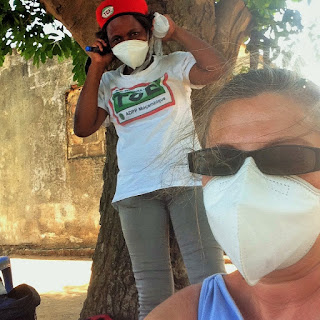 I took my experience from working in a primary school that
scored very low in the Achievement Gap in 2009, especially in reading. This study calculated the gap of students
based on economic issues, race, and educational institutions across America; it
generated new issues of teaching and learning styles, and leadership in our
education domain.
I took my experience from working in a primary school that
scored very low in the Achievement Gap in 2009, especially in reading. This study calculated the gap of students
based on economic issues, race, and educational institutions across America; it
generated new issues of teaching and learning styles, and leadership in our
education domain.
Here the situation is very different; Mozambique is the 6th
poorest country in the world and in the infancy stage of independence, so these
issues of teaching and learning styles is “very interesting”. For the most part the teacher dictates and
the children repeat, my walks passing the school sounds like this:
TEACHER: “THE BIRD IS ON THE TREE” (She is
pointing at a poster taped to the board, yelling so 50 1st graders
sitting on the floor or crammed at a desk have her attention)
STUDENTS: “THE
BIRD IS ON THE TREE”
TEACHER: “THE
BIRD IS RED, WHAT COLOR IS THE BIRD?”
STUDENTS: “THE
BIRD IS RED”.

 I am not an academic scholar, many more informative books
have been written on this topic, but just knowing the students and talking to
them as well as the adults, there are huge red flags in this strategy.
I am not an academic scholar, many more informative books
have been written on this topic, but just knowing the students and talking to
them as well as the adults, there are huge red flags in this strategy.
I have honed it down to one thing that I could
introduce in my village; the skill of CRITICAL THINKING.
In the American culture I believe we have this
skill as second nature; we have talk shows, advertisements, statistics,
competitions – they all challenge our thought processes until we ourselves have
our own opinions, viewpoints, and answers. How many times do we say “let me
think about this?”
We have learned how to think.
We have learned how to think.

 Here, that bird is red, not maroon, not crimson, but just
red. Students don’t need to think about it, they just have to remember what the
teacher told them. Fine for the color red, but what if someday they need an
answer that wasn’t dictated by some teacher? When does that practice start?
Here, that bird is red, not maroon, not crimson, but just
red. Students don’t need to think about it, they just have to remember what the
teacher told them. Fine for the color red, but what if someday they need an
answer that wasn’t dictated by some teacher? When does that practice start? My class started by asking their help to tell the story. I brought in picture books and started
questioning them from the cover. “What do you think this book is about?” “What
is going to happen on the next page?””Would you eat the apple?” They look at the pictures and came up
with many answers, then I guide them to continue thinking for the correct answer. As the pages are turned I asked questions and
pointing out images and in the end they told me the story – I didn’t have to
read the words.
My class started by asking their help to tell the story. I brought in picture books and started
questioning them from the cover. “What do you think this book is about?” “What
is going to happen on the next page?””Would you eat the apple?” They look at the pictures and came up
with many answers, then I guide them to continue thinking for the correct answer. As the pages are turned I asked questions and
pointing out images and in the end they told me the story – I didn’t have to
read the words.

























